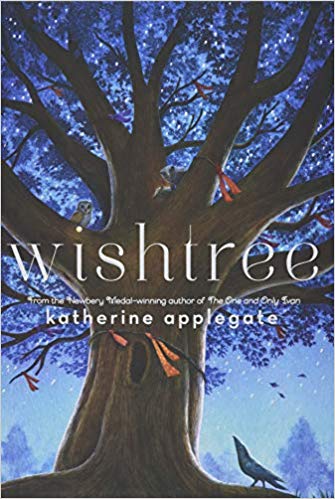“It’s hard to talk to trees. We’re not big on chit chat. That’s not to say we can’t do amazing things, things you’ll probably never do. Cradle downy owlets. Steady flimsy tree forts. Photosynthesize. But talk to people? Not so much.”
With that opening, who wouldn’t want to dive into Katherine Applegate’s latest book, Wishtree (Feiwel and Friends)?
I am a sucker for books with non-traditional narrators, and a story told by a red maple, aka the Wishtree, is just that. This narrator is named Red, but Red explains that trees are simple creatures: all sugar maples are Sugar, all junipers are Juniper, one palm tree in Los Angeles insists on being called Karma, “but you know how Californians can be.” This is the kind of gentle humor that pervades this delightful story.
I just love Applegate’s imagination.
Each type of animal in the story (you knew there would be animals, didn’t you?) has a different and equally amusing naming convention. Crows name themselves for sounds they’ve heard (Bongo), or objects that appeal to them (Jujube, Poptop) and also change their names on a whim. Opossums names themselves after things they are scared of (Flashlight, HairySpiders). Skunks name themselves after nice smells (FreshBakedBread, RosePetal).
Like Applegate’s tour de force, The One and Only Ivan, Wishtree has a good format for early middle grade readers. Short chapters. Simple sentences. A kind and generous view of the world.
But just because the sentences are simple and the chapters are short doesn’t mean this story isn’t packed to the treetops with all kinds of info. We get sneaky vocabulary lessons, including two words I didn’t know: crepuscular, meaning an animal most active at dawn and dusk; and drey, a squirrel’s nest. Also a wonderfully clear lesson on the difference between dioecious and monoecious (a botanical distinction that had always confused me).
We also learn about the tradition of the Wishtree, which has Irish roots (pun intended), and how it evolved in this particular neighborhood.
Even with a kind and generous view of the world, there is conflict. The neighborhood has welcomed newcomers for decades, “different languages, different food, different customs. That’s our neighborhood wild and tangled and colorful. Like the best kind of garden,” says Red. But when Samar’s family, who are Muslim, arrives there is resentment. Plus, as wonderful as Red/Wishtree is, the owner is fed up with stepping on acorns barefoot and raking the leaves every fall. Plus Red’s roots are breaking up the sidewalk and ruining the plumbing. She schedules an appointment with the arborist. Red will be chopped down.
I won’t give away the ending, but I will say, I’ve read Wishtree three times and I cry every time. It’s a beautiful, heartfelt story that is very appropriate for our current times.



0 Comments